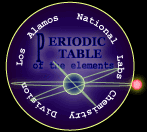

| Atomic Number: | 41 | Atomic Radius: | 142.9 pm | ||
| Atomic Symbol: | Nb | Melting Point: | 2477 �C | ||
| Atomic Weight: | 92.9064 | Boiling Point: | 4744 �C | ||
| Electron Configuration: | [Kr]5s14d4 | Oxidation States: | 5, 3 |
(Named after Niobe, the daughter of Tantalus) Discovered in 1801 by Hatchett in an ore sent to England. The metal was first prepared in 1864 by Blomstrand, who reduced the chloride by heating it in a hydrogen atmosphere. The name niobium was adopted by the International Union of Pure and Applied Chemicstry (IUPAC) in 1950 after 100 years of controversy. Many leading chemical societies and government organizations refer to it by this name. Most metallurgists, leading metal societies, and all but one of the leading U.S. commercial producers, however, still refer to the metal as "columbium."
The element is found in niobite (or columbite), niobite-tantalite, parochlore, and euxenite. Large deposits of niobium have been found associated with carbonatites (carbon-silicate rocks), as a constituent of parochlore. Extensive ore reserves are found in Canada, Brazil, Nigeria, Zaire, and in Russia.
Niobium is a shiny, white, soft, and ductile metal, and takes on a bluish cast when exposed to air at room temperatures for a long time. The metal starts to oxidize in air at 200oC, and when processed at even moderate temperatures must be placed in a protective atmosphere.
Niobium is used in arc-welding rods for stabilized grades of stainless steel. Thousands of pounds of niobium have been used in advanced air frame systems such as were used in the Gemini space program. The element has superconductive properties; superconductive magnets have been made with Nb-Zr wire, which retains its superconductivity in strong magnetic fields. This type of application offers hope of direct large-scale generation of electric power. Niobium is also commonly used for jewelry.
Eighteen isotopes of niobium are known. The metal can be isolated from tantalum, and prepared in several ways.
Niobium metal (99.5% pure) is priced at about $75/lb.
Title Picture: The crystal structure of niobium, body-centered cubic

Sources: CRC Handbook of Chemistry and Physics and the American Chemical Society.
Last Updated: 10/20/2003,� Chemistry Operations
Operated by the University
of California for the US Department
of Energy
|
Help
| Copyright � UC 2003 | Disclaimer